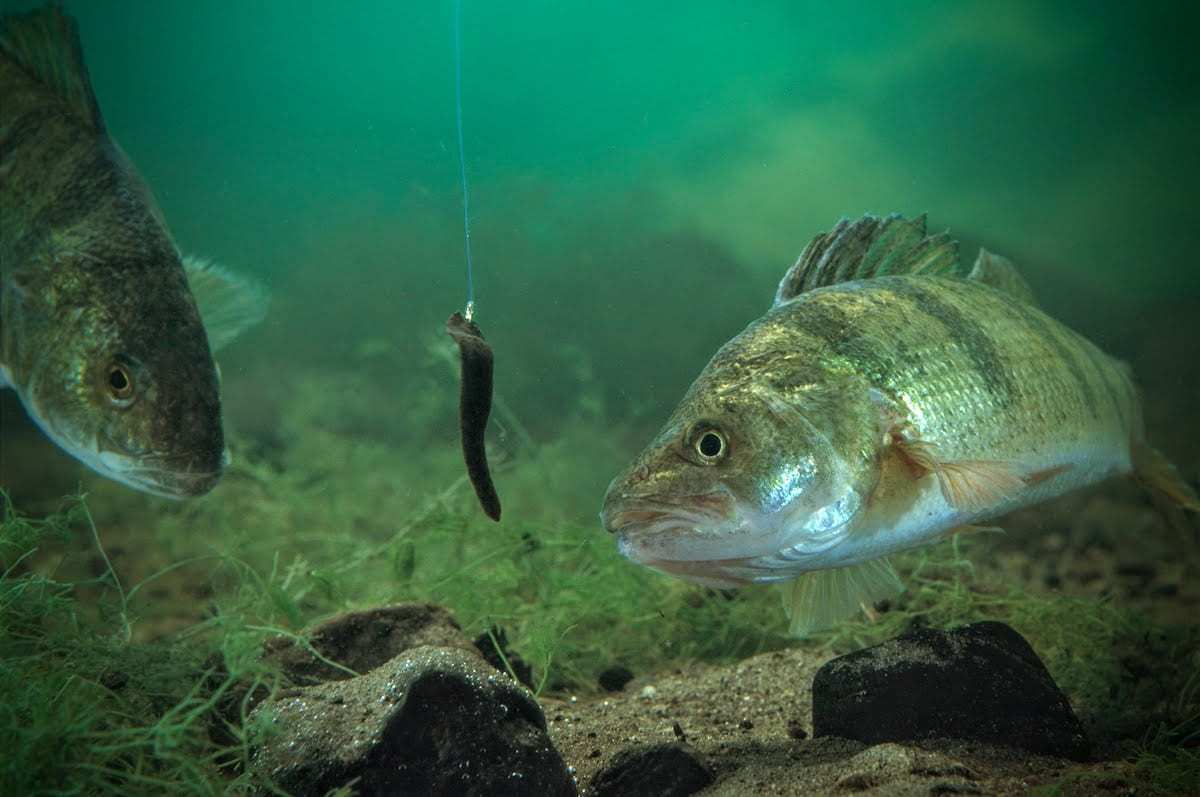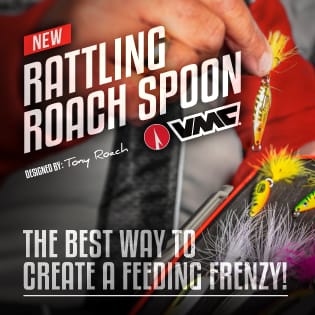It’s been established that invertebrates play a huge role in the feeding ecology of not only the smallest perch and walleye in the lake, but also fish of trophy caliber. They might be followers letting the carp do the work releasing their meals, or they might be grazing on scuds hanging helpless in the water column. However, this is not a game of chance. There are ways that anglers can draw fish in and increase the odds these fish are going to bite.
The Carp Connection
One overlooked aspect to gamefish location is the common carp. Carp actually play a very critical role when understanding gamefish movement because the carp roaming the lake are often followed by fish such as walleye, crappie and perch. This has become a trend for me in large, fishbowl lakes such as Lake Poinsett near Arlington, SD, North of Brookings.
I was lucky enough to discover this trend while pre-fishing for a charity tournament in early January. Poinsett is a large lake with long contours and not much for structure aside from a few humps and some points. There are a few rock piles, but mainly the trend I had found was being close to deep weed patches on mud bottom in 17-18ft of water is the ticket.
Often we would find that our Vexilars would light up with large red lines 2-5ft thick close to or just above bottom. We would catch quite a few walleye and also the occasional crappie or perch. At first, I thought these were extremely large schools of the latter, but I was wrong. Once I set the shack up and cleared the holes, we were able to visually see all the way to the bottom in 17ft of water. As soon as the marks lit up the screen again, we looked down and observed large schools of carp moving through the area. Often the schools of carp would consist of anywhere between 3 to 20 fish, with the average being about 5-10 fish. We observed many walleye, perch and crappie following these schools close behind.
At one point, I spotted one particular school of 3 carp that had a 27 inch walleye right on it’s tail. This walleye spotted my spoon, approached slowly, and eventually bit! The next day we saw another mid-to-upper 20’s walleye swimming with a larger school of carp. We fished this trend for the next two weeks, and it netted us a first place honors for the largest perch at the Fishing 4 Miracles 24 Hour charity tournament. I found one thing interesting about this pattern: this lake is widely famous for its low light bite, but this technique was producing walleye, perch and crappie all day long!
So why is this happening? Our best theory is the carp are stirring chironomids, which are small bugs, out of the mud with their tails, dislodging them into the water column. These bugs present an easy buffet for all game species. Although these prey species are extremely small, they are rich in protein and I believe it’s much more advantageous for even a trophy caliber walleye to follow these carp at a slow speed feasting opportunistically on small bugs than expending energy chasing perch or baitfish all winter long.
How can you apply this to your own fishing? Whenever faced with a large, fairly featureless lake, look for where the water is slightly dirtier or areas that you are seeing carp on either your flasher, underwater camera or even visually in a darker shack. Carp will often stir invertebrates (insects) out from the bottom, and these are high percentage areas for locating game species. Many times the fish are not aggressive or actively hunting. This means a smaller (1/32-1/16oz) spoon with a minnow head, wax worms or spikes is your best option. This produces color, flash and vibration, but can still be fished slowly. More aggressive lures like lipless crankbaits or swimming lures aren’t nearly as effective in these situations.
Low Light Life
The big news around the Dakotas is the expansion of lakes due to flooding. Heavy precipitation events in the 1980’s and 1990’s have led to multiple lakes expanding from small sloughs to larger bodies of water. Areas that were originally dry or small duck ponds now have fishable gamefish populations that are BOOMING! Prime examples of this phenomena are Bitter Lake, Waubay Lake, Dry Lake #2, and Indian Springs/Antelope Complex in South Dakota. Oh, and don’t forget about Devils Lake! Other small, unnamed gems remain dotted across the landscape waiting for a savvy, adventurous angler to reap the benefits of these highly productive, untapped fisheries.
These waterbodies flooded areas that had previously been farmlands. This created the perfect recipe for brand new, extremely fertile fish factories. These farmlands are high in nutrients because they were used to grow row crops and/or raise cattle. These nutrients find themselves in the water system and contribute to the food web at the most basic level. The first level is phytoplankton, these are tiny organisms that use sunlight to produce food for themselves through the process of photosynthesis. These are eaten by larger macroinvertebrates, such as Daphnia or scuds. These are slightly larger invertebrates that can be seen without the aid of a microscope. This level of the food web is critical because it provides food for all fish in the lake at some point or another. Both yellow perch or bluegill consume a large number of macroinverts throughout the year. Juvenile fish of almost every species are going to be feasting on these small inverts during the early stages of their life cycle. It’s no secret that many of the trophy perch waterbodies in the Dakotas are packed full of scuds and other inverts. It is very easy to distinguish these fish as they will often have enormous bodies with very small heads. They develop these wonky dimensions because chowing on tiny forage like this doesn’t require a large mouth. Fish that are feeding on minnows or shiners often need bigger mouths to capture and swallow larger prey.
So why do invertebrates have such an impact on the fishing? It is critical to understand that these bodies of water with booming scud populations are filled with food for fish, especially perch. This means you aren’t sparring with “hungry” fish, making them a little tougher to catch. Often the bite window is very small because there’s so much food available. The best way to get the most bang for your bucks is to fish in low-light conditions. This is when the scuds are most active, which in turn, means it’s also when the perch are most active. These same waterbodies often have booming walleye populations, as well, which are a low light predator regardless.
It’s important to note that these fish are not accustomed to working hard for their meals. This means that the larger and more aggressive presentations typically won’t work. I have found that a small spoon (1/32-1/16oz) with wax worms, spikes or minnow heads is often just enough flash and color to stand out and draw the fish’s attention, without being overly intimidating. It is important not to work the spoon too aggressively once the fish are on screen and generally a slight wiggle in their face is the best way to seal the deal.
Stir the Pot
Gamefish are extremely opportunistic feeders. This means that when food is present, or they think that food is present, they’ll take the opportunity to snag an easy meal. Imagine walking into your favorite restaurant and finding out they are giving away free food all day long and the place is packed! You might not have been hungry when you walked in, but as soon as you see everyone eating for free, your stomach is going to start howling like a wolf. The same thing is happening down in the depths. The best attractors of fish is other fish. If they think their buddies are somewhere enjoying a free steak dinner, they are going to check it out. Anglers can use this to their advantage and draw fish in, even when there are no fish around.
It’s all about your jigging cadence and bait selection. I mentioned earlier that once fish are on the screen more subtle movements are often best. However, when your screen is completely void of fish, the best way to draw them in is with violent jigging strokes.
In the Glacial Lakes region of South Dakota, the majority of the lakes are extremely clear below the ice. Algae and other sediments have settled to the bottom and there’s no wind to “stir the pot”. This means fish can see a long ways away. In these waterbodies, flashy flutter spoons worked high — 4 to 6ft off bottom — can draw fish in from great distances.
However, on more stained bodies of water like Lake of the Woods this approach is not near as effective and a different strategy is need. Try aggressively beating the bottom with your lure, creating a large poof of silt and mud. Why is this so effective? On Lake of the Woods, perch anglers will often know they had a good day of fishing by the mess of blood worms around their holes. Bloodworms are exactly what they sound like: small worms that are buried down in the mud that the perch root out of the bottom and eat. The same concept applies to the other chironomids that are being stirred up by the carp as discussed before. This creates a disturbance that under the stillness of the ice, looks like an atomic bomb went off. This attracts other fish to the area thinking there’s a meal to be had.
I like to use a compact presentation like a rattle spoon or slab spoon. This allows solid contact with the bottom and creates a significant disturbance in the silt and mud. After a couple good impacts, I like to give a violent rip and some aggressive jigging strokes up off the bottom, similar to what you might do with flashy spoons. This is effective for so many species for so many reasons.
The first species is yellow perch. They are used to digging invertebrates out of the bottom and it mimics another perch foraging and thus attracting buddies, much like the diner with all of your friends. One fish swimming over and checking it out is going to draw more to the area. Should you catch that fish, the thrashing of it will also create a disturbance and draw in more fish to check out the scene.
The second species is walleye. This jigging stroke doesn’t need to mimic a fish foraging. It could be a small prey fish that is either wounded or dying, using its last strength attempting to pull itself off bottom, but then failing time and time again. This looks like an easy meal that will literally fall right into a walleye’s mouth. It’s another case of a fish feeding opportunistically when the meal is worth the little work required to obtaining it.
The third species is northern pike. The same thought process of a dying baitfish applies to northern, however if a small perch is investigating what it believes is another fish foraging then it may not notice a large predator right behind it. This makes for an easy meal for a stealthy pike.
Don’t be afraid to work low in the water column like this. We are trained as soon as we start ice fishing that the higher we get a fish, the more likely it is to bite. This is a good mentality, but not necessary written law. It is important to know that fish like perch and walleye are used to getting their meals off the bottom. They have no issue digging your presentation out of the mud. The reason most people work it off is to visually attract fish from a distance, which can be very true. This presentation does an excellent job drawing fish in, but also maintaining that natural approach. If the bait is on the bottom, the fish are going to be focusing on the bottom as well.
Conclusion
It is highly beneficial for anglers to understand the forage of their target species. This helps set up location and presentation patterns before they arrive at the lake. Most of these lakes are very similar, and though location and depth may be different, the same concepts are going to apply to most of the lakes in the same region. Making simple observations on the water, whether it’s on your flasher or around your hole, is the best way to make these determinations. Not only does it help paint the picture of what is going on below the ice, but it makes you a more educated angler.










